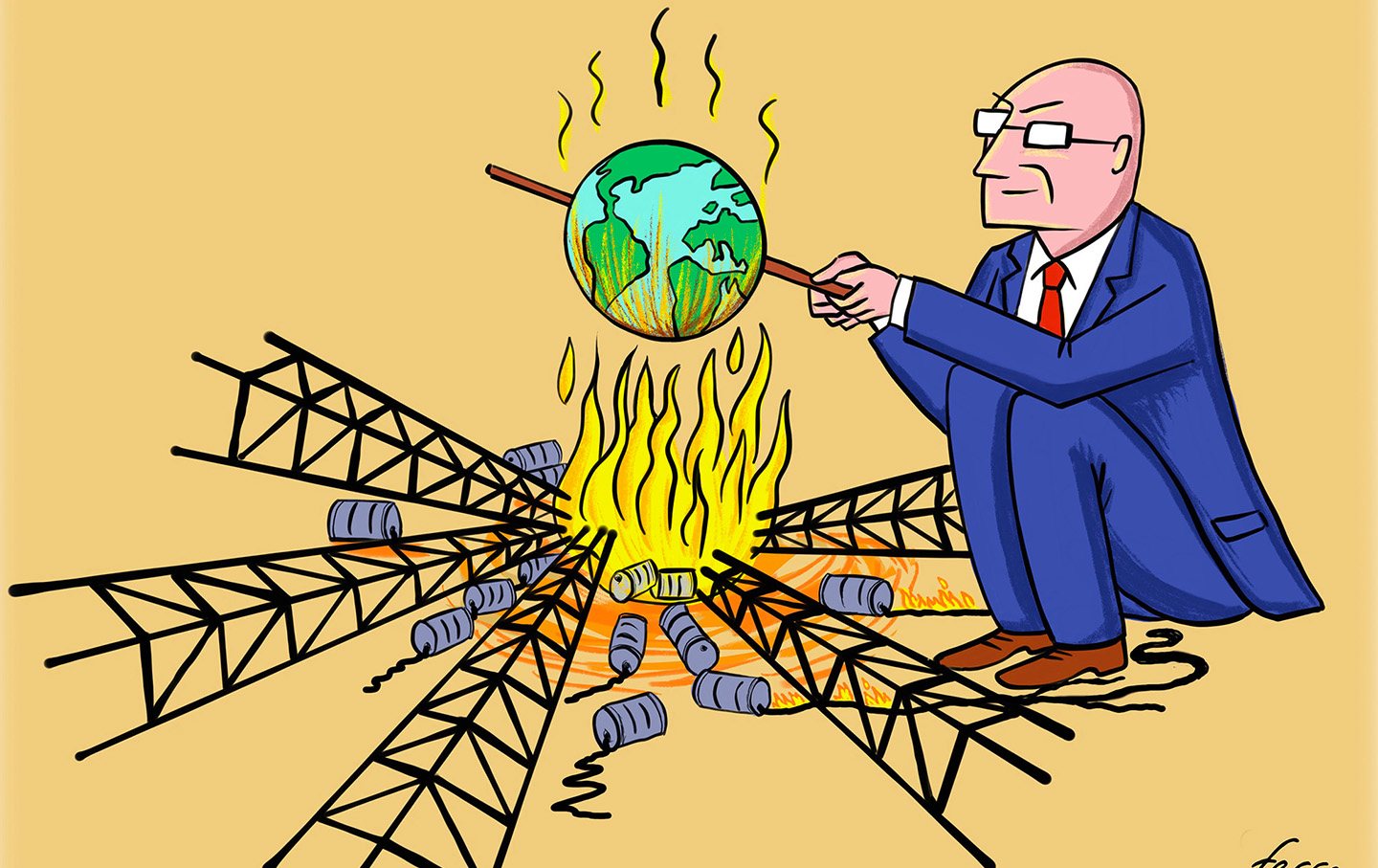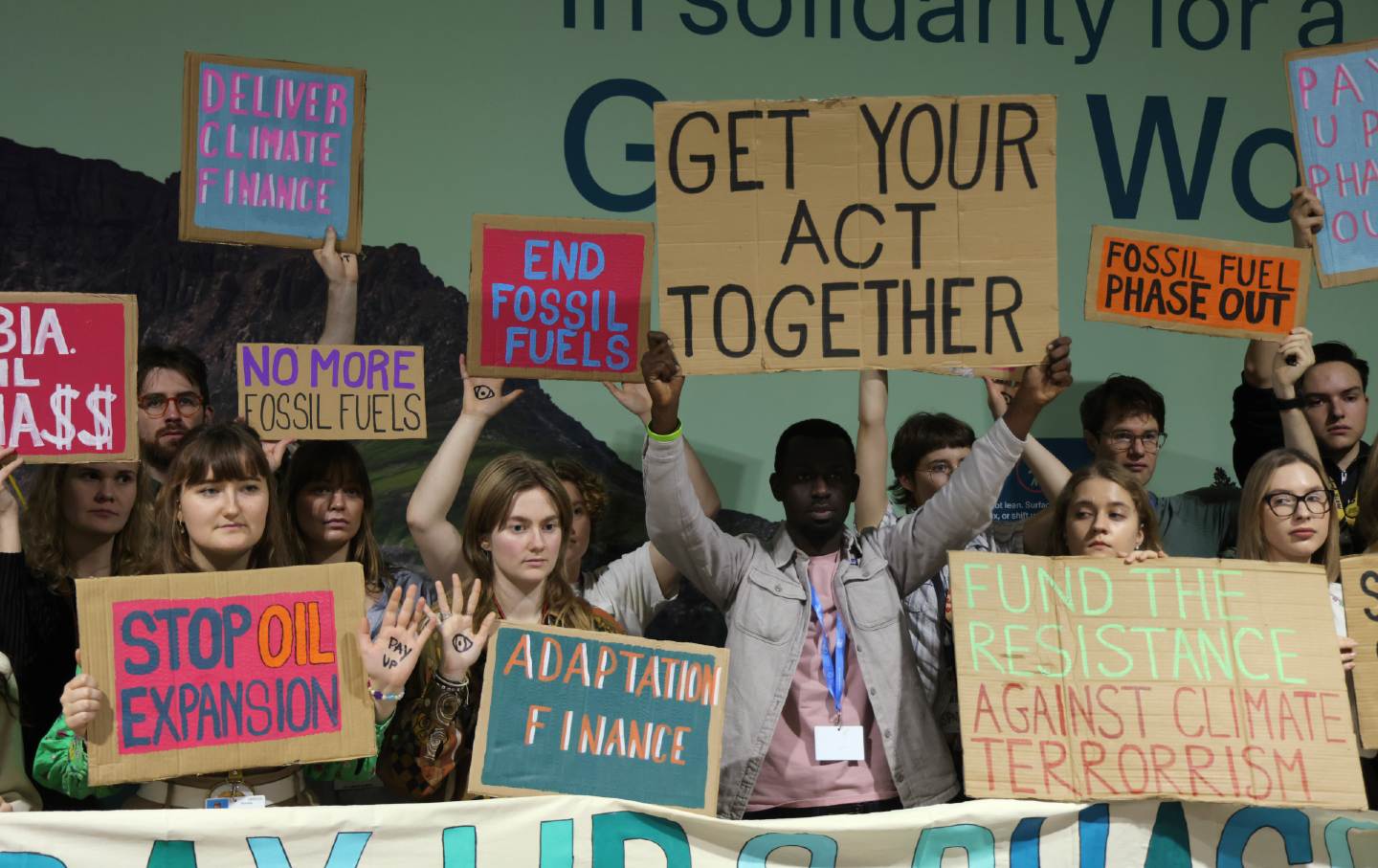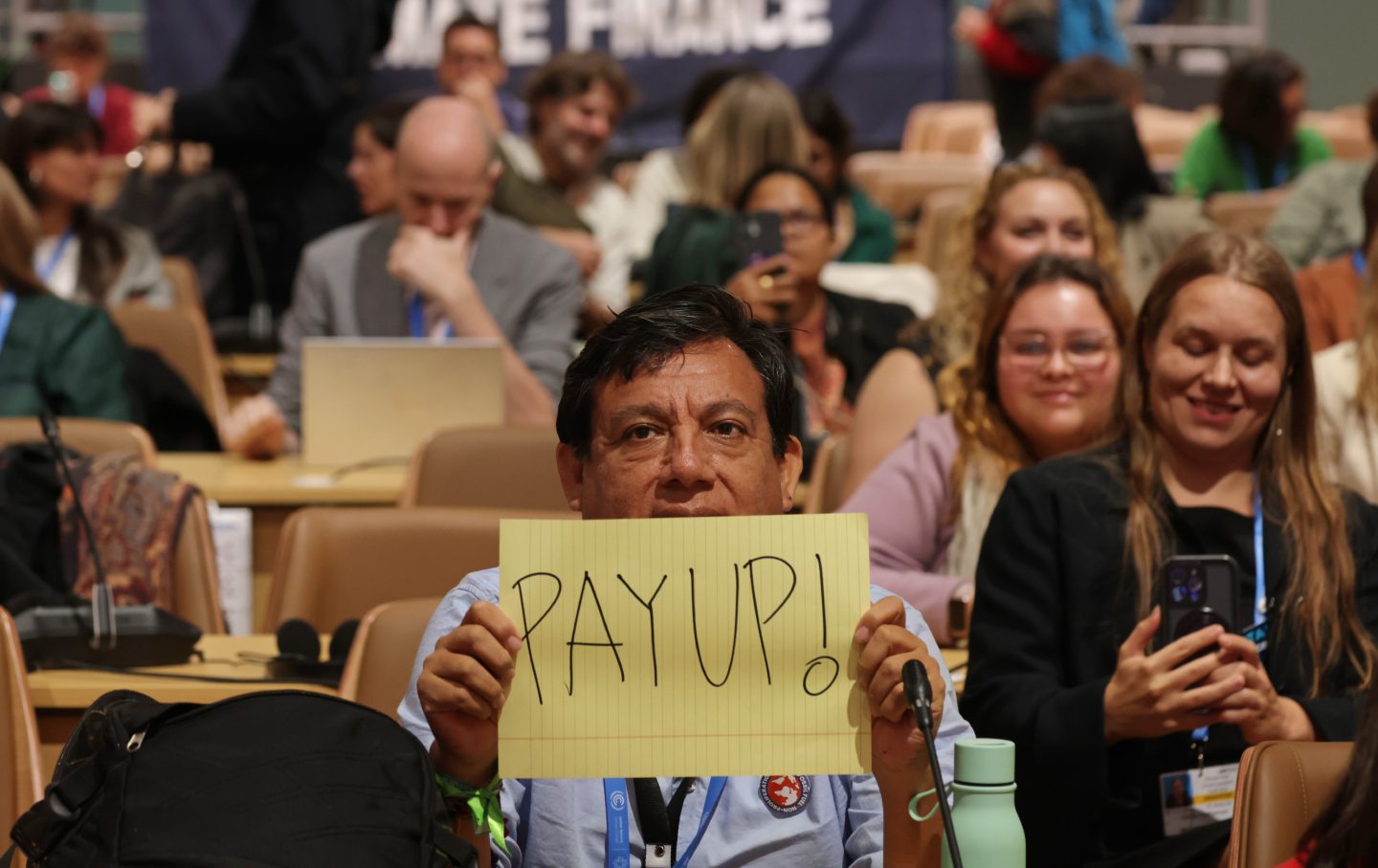The Plundering of the South China Sea
We’re not going to mine our way out of the climate crisis.

Sailors observe the USS Nimitz (CVN 68) and USS Ronald Reagan (CVN 76) Carrier Strike Groups steam in formation as the Nimitz Carrier Strike Force (CSF) in the South China Sea.
(3rd Class Dalton Reidhead / Defense Department)This article originally appeared at TomDispatch.com. To stay on top of important articles like these, sign up to receive the latest updates from TomDispatch.com.
It’s an ocean of conflict and ecological decline. Despite its vast size—1.3 million square miles—the South China Sea has become a microcosm of the geopolitical tensions between East and West, where territorial struggles over abundant natural resources may one day lead to environmental collapse.
While the threat of a devastating military conflict between China and the United States in the region still looms, the South China Sea has already experienced irreparable damage. Decades of over-harvesting have, for instance, had a disastrous impact on that sea’s once-flourishing fish. The tuna, mackerel, and shark populations have fallen to 50 percent of their 1960s levels. Biologically critical coral reef atolls, struggling to survive rising ocean temperatures, are also being buried under sand and silt as the Chinese military lays claim to and builds on the disputed Spratly Islands, an archipelago of 14 small isles and 113 reefs in that sea. Taiwan, the Philippines, Malaysia, and Vietnam have also laid claim to many of the same islands.
Perhaps no one should be surprised since oil and gas deposits are plentiful in the South China Sea. The US government estimates that 11 billion barrels of oil and 190 trillion cubic feet of natural gas are ready to be extracted from its floor. Such fossil-fuel reserves, some believe, are helping to—yes, how can anyone not use the word?—fuel the turmoil increasingly engulfing the region.
This year, the Washington-based Asia Maritime Transparency Initiative reported that several countries are pursuing new oil and gas development projects in those contested waters, which, the organization notes, could become a “flashpoint in the disputes.” Between 2018 and 2021, there were numerous standoffs between China, Vietnam, and other Southeast Asian countries over drilling operations there, and fears are building that even more severe confrontations lie ahead.
The United States, of course, lays the blame for all of this on China, claiming its aggressive island-reclamation projects violate international law and “militarize an already tense and contested area.” Yet the US is also playing a significant part in raising tensions in the region by agreeing to supply Australia with nuclear-powered submarines as part of its Australia–United Kingdom–United States (AUKUS) security pact. The goal, no doubt, is to restrain Chinese activity with the threat of Western military might. “Next steps could include basing US nuclear-capable platforms—such as strategic bombers—in Australia as well as cooperation on hypersonic missiles, cyber operations, [and] quantum computing,” writes Derek Grossman for the Rand Corporation, the “paramilitary academy” of American defense policy. (And, in fact, the United States is evidently preparing to deploy the first nuclear-capable B-52s to that country soon.)
On August 25, in partnership with Australia and the Philippines (where Washington is getting ready to occupy bases ever closer to China), US Marines practiced retaking an “island” supposedly captured by hostile forces. In that exercise,1,760 Australian and Filipino soldiers and 120 US Marines conducted mock beach landings and air assault maneuvers in Rizal, a small town in western Palawan province in the Philippines, which does indeed face the South China Sea.
“A whole lot of damage can be done to Australia before any potential adversary sets foot on our shores and maintaining the rules-based order in Southeast Asia, maintaining the collective security of Southeast Asia, is fundamental to maintaining the national security of our country,” said Australian Defense Minister Richard Marles of the joint military drills.
Like AUKUS itself, those war games were intended to send a message: China beware. The resources of the South China Sea aren’t for the taking.
But here’s a question to consider: Is all this international saber-rattling only about fossil fuels? Trade routes through the area are also vital to the Chinese economy, while its fisheries account for 15 percent of the reported global wild fish catch. Yet neither its well-used shipping routes, necessary as they are to the flow of goods globally, nor those fisheries fully explain the ever-heightening controversy over the region. Having exploited that sea’s wild fisheries for decades, China is now becoming a global leader in fish farming, which already accounts for 72 percent of the country’s domestic fish production, It’s also increasingly true that fossil fuels have a distinct shelf life. But is it possible that another set of natural resources, arguably more crucial to the economic future of the global superpowers, could be adding to the growing territorial furor over who possesses the goods in the South China Sea?
Mining the Deep Blue Sea
You could call it a race to the bottom, with China leading the charge. In December 2022, that country unveiled its Ocean Drilling Ship, a deep sea mining (DSM) vessel the size of a battle cruiser set to be operational by 2024. Instead of weaponry, however, the ship is equipped with advanced excavation equipment capable of drilling at depths of 32,000 feet. On land, the Chinese already hold a virtual monopoly on metals considered vital to “green” energy development, including cobalt, copper, and lithium. Currently, the Chinese control 60 percent of the world’s supply of such “green” metals and are now eyeing the abundant resources that exist beneath the ocean’s floor as well. By some estimates, that seabed may contain 1,000 times more rare earth elements than those below dry ground.
It’s difficult to believe that devastating the ocean’s depths in search of minerals for electric batteries and other technologies could offer a sustainable way to fend off climate change. In the process, after all, such undersea mining is likely to have a catastrophic impact, including destroying biodiversity. Right now, it’s impossible to gauge just what sort of damage will be inflicted by such operations, since deep-sea mining is exempt from environmental impact assessments. (How convenient for those who will argue about how crucial they will be to producing a greener, more sustainable future.)
The UN’s High Seas Treaty, ratified in March 2023, failed to include environmental rules regulating such practices after China blocked any discussion of a possible moratorium on seabed harvesting. As of 2022, China holds five exploration contracts issued by the UN’s International Seabed Authority (ISA), allowing the Chinese to conduct tests and sample contents on the ocean floor. While that UN body can divvy up such contracts, they have no power to regulate the industry itself, nor the personnel to do so. This has scientists worried that unfettered deep-sea mining could cause irreparable damage, including killing sea creatures and destroying delicate habitats.
“We’ve only scratched the surface of understanding the deep ocean,” said Dr. Andrew Chin, a scientific adviser to the Australian-based Save Our Seas Foundation.
Popular
“swipe left below to view more authors”Swipe →“Science is just starting to appreciate that the deep sea is not an empty void but is brimming with wonderful and unique life forms. Deep sea ecosystems form an interconnected realm with mid and surface waters through the movement of species, energy flows, and currents. Not only will the nodule mining result in the loss of these species and damage deep sea beds for thousands of years, it will potentially result in negative consequences for the rest of the ocean and the people who depend on its health.”
Others are concerned that the ISA, even if it had the authority to regulate the budding industry, wouldn’t do it all that well. “Not only does the ISA favor the interests of mining companies over the advice of scientists, but its processes for EIA [environmental impact assessment] approvals are questionable,” says Dr. Helen Rosenbaum of the Deep-Sea Mining Campaign.
This brings us back to the South China Sea, which, according to Chinese researchers, holds large reserves of “strategically important” precious metals. China has already been fervently scouting for deposits of the polymetallic nodules that hold a number of metals used in virtually all green technologies.
“Learning the distribution of polymetallic nodules will help us to choose a site for experimenting with collection, which is one of the main goals of the mission,” said Wu Changbin, general commander of the Jiaolong, a submarine that discovered just such polymetallic nodules in the South China Sea.
Unsurprisingly, the United States, lagging behind China in acquiring minerals for green technologies, has been keeping close tabs on the competition. In 2017, a Navy P3-Orion spy plane conducted repeated flyovers of a Chinese research vessel near the island of Guam. Scientists on the ship were allegedly mapping the area and planting monitoring devices for future deep-sea exploration.
The story is much the same in the South China Sea, where the US has conducted numerous surveillance operations to follow Chinese activities there. In May, an Air Force RC-135 surveillance plane was intercepted by a Chinese J-16 jet fighter, causing an international uproar. Without providing any justification for why a US spy plane was there in the first place, Secretary of State Anthony Blinken quickly pointed the finger at China’s recklessness. “[The] Chinese pilot took dangerous action in approaching the plane very, very closely,” claimed Blinken. “There have been a series of these actions directed not just at us, but in other countries in recent months.”
While these quarrels no doubt have much to do with control over fossil fuels, oil, and natural gas aren’t the only resources in the region that are vital to the forthcoming exploits of both countries.
Capitalism and the Climate
Across the globe, oil and coal are increasingly becoming things of the past. A report released in June 2023 by the International Energy Agency (IEA) suggested that renewables were “set to soar by 107 gigawatts (GW), the largest absolute increase ever, to more than 440 GW in 2023.” The natural resources supplying this global surge in renewables, like copper and lithium, are becoming the popular new version of fossil fuels. Markets are favoring the phase-out of climate-warming energy sources, which is why China and the United States are forging ahead with mining critical minerals for renewables—not because they care about the future of the planet but because green energy is becoming profitable.
China’s foray into the global capitalist system and the ruins left in its wake are easy enough to track. In the late 1970s, China’s leaders liberalized the country’s markets and opened the floodgates on foreign investment, making it—at an average clip of 9.5 percent per year—one of the fastest-growing economies ever. The World Bank described China’s financial boom as “the fastest sustained expansion by a major economy in history.” It’s no surprise, then, that energy consumption exploded along with its economic gains.
Like many of its global competitors, China’s economy still relies heavily on carbon-intensive fossil fuels, especially coal, but an ever-growing portion of its energy portfolio is made up of renewable energy. Steel-making and vehicle manufacturing now account for 66 percent of China’s energy use, transportation 9 percent, and residential use 13 percent. And while coal is still fueling that economic engine in a major way—China uses more coal than the rest of the world combined—the country has also become a (if not the) world leader in renewables, investing an estimated $545 billion in new technologies in 2022 alone.
While China uses more energy than any other country, Americans consume significantly more than two times that of the Chinese on an individual basis (73,677 kilowatts versus 28,072 as of 2023). And while the United States uses more energy per person, it also gets less of its energy from renewables.
As of 2022, the US government estimated that only 13.1 percent of the country’s primary energy was produced through renewable sources. Even so, the energy transition in the US is happening and, while natural gas has largely replaced coal, renewables are making considerable inroads. In fact, the Inflation Reduction Act, signed into law by President Biden in early 2022, earmarked $430 billion in government investment and tax credits for green-energy development.
The World Economic Forum estimates that three billion tons of metals and fine minerals will be needed for the world’s energy transition if we are to reach zero carbon dioxide emissions by 2050—and that number will undoubtedly only grow in the decades ahead. Of course, investors love to cash in and the forthcoming explosion in the mining of green metals on land and in the world’s waters will surely be a windfall for Wall Street and its equivalents globally. BloombergNEF (BNEF), which covers global markets, claims that the demand for key metals and minerals for the energy transition will grow at least fivefold over the next 30 years, which represents something like a $10 trillion opportunity. At stake is the mining of critical minerals like lithium and traditional metals like copper, which will be used in power generation, electrical grids, energy storage, and transportation.
“[T]he energy transition could lead to a super-cycle for the metals and mining industry,” says Yuchen Huo, a mining analyst for BNEF. “This cycle will be driven by massive expansions in clean energy technologies, which would spur demand growth for both critical minerals and traditional metals.”
It should be no surprise, then, that countries like China and the United States are likely to battle (perhaps all too literally) over access to the finite natural resources vital to the world’s energy transition. Capitalism depends on it. From Africa to the South China Sea, nations are scouring the globe for new, profitable energy ventures. In the Pacific Ocean, which covers 30 percent of Earth’s surface, the hunt for polymetallic nodules is prompting island governments to open their waters to excavation in a significant way. The Cook Islands has typically issued licenses to explore its nearby ocean’s depths. Kiribati, Nauru, and Tonga have funded missions to investigate deposits in the Clarion Clipperton Zone, a 1.7 million square mile area stretching between the island of Kiribati and Mexico.
“This [deep sea] exploration frenzy is occurring in the absence of regulatory regimes or conservation areas to protect the unique and little-known ecosystems of the deep sea,” contends Dr. Rosenbaum of the Deep-Sea Mining Campaign. “The health and environmental impacts of deep-sea mining will be widespread.… The sea is a dynamic and interconnected environment. The impacts of even a single mine will not be contained to the deep sea.”
According to those who want to mine our way out of the climate crisis, such highly sought-after metals and minerals will remain crucial to weaning the world off dirty fossil fuels. Yet, count on one thing: They will come at a grave cost—not only geopolitically but environmentally, too—and perhaps nowhere will such impacts be felt more devastatingly than in the world’s fragile seas, including the South China Sea where major armed powers are already facing off in an unnerving fashion, with the toll on both those waters and the rest of us still to be discovered
More from The Nation

This Solar Panel Kills Fascists This Solar Panel Kills Fascists
New York’s Build Public Renewables Act will reduce carbon in the atmosphere, combat inequality, and help workers. It might also defeat Trumpism.

Global Burning Global Burning
The oil industry denies climate change, opposes regulations, and significantly contributes to the environmental crisis.

The “Worst COP” Concludes With a “Heartbreaking” Climate-Finance Deal The “Worst COP” Concludes With a “Heartbreaking” Climate-Finance Deal
Activists say the climate agreement effectively signed away the 1.5-degree Celsius target—”our only real chance to safeguard humanity’s future.”

Rich Countries Must Pay Up or Humanity Will Pay the Price Rich Countries Must Pay Up or Humanity Will Pay the Price
The climate activist Lidy Nacpil says the climate bill owed to developing nations is in the “trillions, not billions.”

Climate Change Is the Real National Security Threat Climate Change Is the Real National Security Threat
In the wake of Hurricanes Helene and Milton, it’s clear we’re defending against the wrong perils.

Acting on Climate Change? Acting on Climate Change?
The opportunity is melting away.


